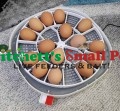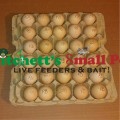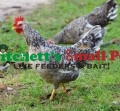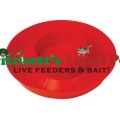 Loading... Please wait...
Loading... Please wait...Product Description
The Rhodebar is my new Favorite. They are so friendly. They follow us around the yard and are great foragers. Our RhodeBars are dual purpose, lay large brown eggs through hot and cold weather, and are very social. They are also great mothers. I've had several to go broody. They develop wonderful personalities and I have never had any of them to show aggression. This is one of the most famous and all time popular breeds of truly American chickens bred to show Sex Linked Traits at birth. Developed in the early part of this century in Britain and imported in the usa by GreenFire Farms a few years ago, they have maintained their reputation as a dual purpose fowl. Outstanding for production qualities, they have led the contests for brown egg layers time after time in Britain. Our strain is keeping up the fine reputation of this old favorite. For the fans of the Rhode Island Red this is the breed for you. They are a Rhode Island Red with the Barring Gene to give them their autosexing capability. Baby chicks can be sexed by anyone at any age. They are a popular choice for backyard flocks because of their egg laying abilities and hardiness as well as their autosexing gene which will allow small farms to keep the pullet chicks and a male or two just to keep them around the farm, and to sell the surplus.
Our Rhodebars lay brown eggs, not green as some people received from Greenfire Farms near the end. The original Rhodebars they sold were brown egg layers. Later they added something to them, maybe as a project or possibly by mistake but many people got Rhodebars with crests and green eggs. It is my opinion they added a cream legbar to them to either make a new autosexing breed or because they lost some breeding stock and thought they could make the cross with no harm. After folks got some of their mixed up fowl they sold as Rhodebars, Greenfire Farms removed them from their website. Many people reached out to them about their breeding practices to see where the mistake was made, and they never got answers.
Here is the original text from the Greenfire Farms website before Greenfire Farms deleted their page and quit breeding them.
Rhodebars are the uniquely wonderful offspring of a shotgun marriage between the Yanks and the Brits. In 1947, British geneticists crossed Rhode Island reds (the quintessential America barnyard chicken) with golden brussbars (a rare British breed) to create an auto-sexing chicken breed with striking red barring and the ability to annually lay hundreds of extra large eggs. (To learn more about auto-sexing chickens please read about Greenfire Farms cream legbars on this website.) Rhodebars enjoyed brief favor in Britains commercial poultry flocks until they were bypassed by more modern hybrids.
Despite their unusual good looks and solid record of production, today rhodebars are virtually extinct. It is estimated that fewer than a hundred hens remain in Britain, and until now none were known to exist outside that country. The threat to this breed potentially creates the loss of a wonderful genetic treasure since a hen from a good strain of rhodebars will produce over two hundred very large tinted eggs a year. And, rhodebars are perhaps more effective at auto-sexing than any chicken breed in the world: Yellow chicks are males and chicks with chipmunk stripes on their backs are females. The visual distinction between the two sexes is striking.
Greenfire Farms was able to import some of the last remaining rhodebars, and we introduced into the breeding flock both production and traditional strains of American Rhode Island reds. These American birds injected some much-needed genetic diversity into the rhodebar line and produced birds that are extremely prolific egg layers. By back-breeding these crosses to pure rhodebars we were eventually able to produce a rhodebar bloodline with all the characteristics of pure rhodebars (including auto-sexing) and the productivity of a modern commercial chicken. Arguably, this makes our rhodebars the ultimate fowl for homesteaders and small-scale producers: a bird that is prolific as it is beautiful with the enormous added benefit of being auto-sexing. These traits are sure to quickly endear the rhodebar to Americas poultry enthusiasts.
Males weigh in at around 8 lbs while females are 6 lbs.
Chicken Facts:
Poultry Show Class: None Yet
Weights: Hens 6 lbs, Roosters 8 lbs, Pullets 5-6 lbs, Cockerel 7-8 lbs
Purpose: Dual Purpose (Eggs & Meat)
Egg Shell Color: Brown Egg
Production: Very Good: 200 - 280 eggs per year
Country of Origin: Britain
APA: No, but in the works!
ALBC: Recovering Status, Considered a sustainable heritage chicken breed
BREEDER: Pritchett's Small Pets
Our Breeding Strategy for our Greenfire Farm's Imported Rhodebars (Production)
Our production Rhodebars are bred to Britains Standard of Perfection for egg production first, and then for type, barring, and color. They are not guaranteed to be show winners but they will be egg laying machines. Our breeders are culled beginning at the day of hatch. We start by keeping chicks that are 100% easy to sex. To be qualified for a future breeder our male chicks must be of a washed out color with a big white head spot. Our pullet chicks must be clearly sexable, any faintly striped chicks or yellow chicks are culled. After the chicks grow up we keep looking for undesirable traits and culling hard. We breed them the same way every year and use the Spiral Breeding Method to ensure we get the best quality and best production from our birds. Our hens are single mated or monitored by trap nests, all data is logged into our poultry breeding management software and we keep strict records using ZooEasy Standalone so that we can keep the strongest and healthiest hens that produce the most eggs as possible. We do not try to breed the broodiness out of our hens as this trait is something we encourage because mother nature can always do things better than an incubator.
The Poultry Club of Great Britain
Breed Standard for the Rhodebar
GENERAL CHARACTERISTICS : MALE
Carriage: Upright and graceful.
Type: Body large, fairly deep, broad and long. Back broad, long and somewhat horizontal in outline. Breast broad, full and well rounded. Wings carried well up, the bows and tips covered by breast feathers and saddle hackle. Tail rather small, rising slightly from the saddle, the sickle of medium length, well spread and nicely curved, the coverts being sufficiently abundant to cover the stiff feathers.
Head: Strong, but not thick. Beak moderately curved, short and stout. Eyes large and bright. Comb single, medium size, straight, upright, well set on, with well-defined serrations, and free from side sprigs. Face smooth. Ear-lobes of fine texture, well developed and pendant. Wattles to correspond with size of comb and moderately rounded.
Neck: Of medium length and profusely covered with feathers flowing over the shoulders, but not too loosely carried.
Legs and feet: Legs wide apart and of medium length, stout and strong and free from feathers. Thighs large with well rounded shanks of medium length. Toes four, strong, straight and well spread.
Plumage: Of silky texture, free from coarse or excessive feather.
Handling : Firm with abundance of muscle.
FEMALE
The general characteristics are similar to those of the male, allowing for the natural sexual differences.
COLOUR
Plumage, Male: Hackle deep red-gold barred, with centres black and grey-white barred, the black centre portions rather longer than the grey-white; the front of the cape showing less black, the feathers towards the tips of the cape lying on the back showing wider black and grey-white barring. Wing primaries, lower web red-gold, faintly barred, upper grey and white barred, slightly gold tinted; secondaries, the whole alternately black, white and gold barred, lower web showing more gold; flight coverts very bright red-gold and white barred, tips red-gold. Wing bows very brilliant chestnut red and gold barred. Tail, including sickles, uniform black and white barring from tip to base, including the shaft. Tips black. Saddle hackle deed red-gold and grey-white and narrower black barring towards the tips. Back and saddle deep red-gold barred, with occasional black bars towards the end of the feathers. Undercolour light creamy buff. Breast uniformly barred, deep red-gold and creamy white and black.
Plumage, Female : Hackle deep buff red with bright chestnut edges, each feather with deep buff, gold, black and white narrow barring, the barring becoming narrower as it approaches the lower cape feathers. Tail feathers black with reddish tinge. Wing primaries, upper web red-buff, lower black; secondaries buff-red. Remainder, general surface dark buff-red barred with buff and buff-red, the tips of the feathers of the lighter colour. Undercolour creamy buff-red, as deep as possible. Quills yellow.
In both sexes: Beak red-horn or yellow. Eyes orange or red, pupils clearly defined. Comb, face, ear lobes and wattles bright red. Legs and feet bright yellow.
Standard Weights :
Cock: 8½lb (minimum); Cockerel 8lb .
Hen: 6½lb (minimum); Pullet 5½lb
SCALE OF POINTS
Type 30
Colour 20
Legs 10
Condition 15
Head 20
Weight 5
100 Points
Serious Defects : Male's comb twisted or falling over. Ear-lobes other than red. Legs other than yellow, orange or light willow. Squirrel or wry tail. Side sprigs on the comb. Eye pupils other than round and clearly defined. Crooked breast or any bodily deformity.













